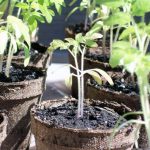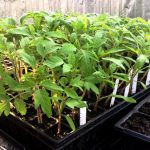I’VE had two incidents in the last week where tomatoes I brought in from the tunnel tasted like they had gone off. Probably because they had gone off, I suppose. The tomato plants are looking pretty bedraggled now and there are only a couple of dozen of toms left, but they aren’t in great nick to be honest. I think I pretty much have to accept that the tomato season is over.
It’s not bad to have made it to the end of October. I might leave one or two plants where they are until next Wednesday, just so I can say that ‘I had tomatoes right up to November’. These are the kind of things that matter to me.
Thankfully, my tomato obsession was satiated by a bumper crop this year. At times this year we literally struggled to cope with the volumes of tomatoes coming in from the veg patch. I put pretty much every recipe I could think of to work, making sauces, salsas and ketchups. I pickled them, sun-dried them and put them into chutneys.
Our new bigger tunnel was all about the premise that you could ‘never have too many tomatoes’ – this year I had to admit you come to a point where you actually can.
So anyway, we’ve enough tomato sauce in bags in the freezer to keep us going right up until the new tomato season next summer. But for now the joy of freshly picked tomatoes has passes, and it feels like it was a pretty short season.
We live in a post-seasonal world, where every vegetable is in season somewhere around the world and there’s a transport system to facilitate its speedy movement from point A to point B. That’s all fine and dandy but there are two problems with this so far as I can see.
Firstly, the veg shipped in from the other side of the world just can’t compete flavour wise with something that’s just picked. Secondly, and perhaps this is more important, the lack of seasonality means we’ve become tone deaf to our body’s needs at different times of the year. There’s a reason we’re less interested in salads and more into soups as the winter comes in, and by eating seasonally you tune in to that wisdom.
When a staple veg like the tomato goes out of season, a question is asked of you: do you want to forget about tomatoes until next year, or start eating an imported version until next summer? Somewhere in the world (usually Spain or Holland), they will be able to grow tomatoes all through the winter and supermarkets will import vast quantities of them. The question is, will they taste as nice? Does your body need them?
Personally, I’ll be signing off fresh tomatoes until next summer. I’ll miss them dearly, particularly at breakfast time, but abstinence will make next summer’s new crop all the sweeter.
The Basics – Put Up Herbs
HOME-grown herbs can make every meal feel like it was produced in your garden – this can be particularly important in winter months when you may not have so much fresh produce available (if any at all!). Potting up herbs and growing them on indoors is a great way to maintain a consistent supply of fresh herbs such as thyme, rosemary and sage through the winter months and save yourself money.
As long as they get some sunlight, water and air, they will do well indoors and this is a great time of the year to start them(they have time to get settled and established before winter). They should show signs of growth about three to four weeks after potting up and continuous harvesting will encourage growth. They will grow slowly over the winter but they will grow – and they should be able to keep you in herbs for the winter months. They can also be planted out again in the spring.
Use relatively small plants (about half a foot) which will grow happily in six-inch pots. Dedicate a pot to each herb if you can. Getting the balance right with drainage is important. Herbs don’t like to sit in wet soil, but potted herb plants always dry out quicker than they would in open ground. So keep a close eye on them-only water every two weeks or so. Make sure there are drainage holes in the pots and don’t use garden soil – potting compost is better aerated. Keep the herbs in a sunny location.
To pot them up: Fill the pot about two thirds of the way up. Create a well in the middle and put the plant in it gently. Fill in the well with the remainder of the compost and firm in gently.
Tip of the week
Leek Risotto with Parmesan Crisps
THIS Nigel Slater recipe makes a meal from some fresh leeks and a handful of store cupboard ingredients – always a winner in my book.

INGREDIENTS
- 2 medium leeks,
- Thick slice of butter
- 3-4 tarragon stalks, leaves only
- 2 good spilling handfuls of arborio rice (about 200g/7oz)
- 175ml/6fl oz wineglass dry white wine
- 1 litre/1pint 15fl oz hot homemade chicken stock (the stock can be made from leftover roast chicken)
- Salt and freshly ground black pepper
- 2 heaped tablespoons finely grated parmesan cheese
METHOD
- Scatter the chopped leeks into a large shallow pan, add the butter and some tarragon leaves and cook over a gentle heat, stirring from time to time, until the leeks soften and become translucent but not coloured, about 12-15 minutes.
- Stir in the rice to coat the butter, then add the wine and let it bubble until the liquid has pretty much disappeared.
- Little by little add the hot stock, a couple of ladlefuls at a time at the most.
- When the rice absorbs the liquid and starts to diminish in the pan, you can add another ladle or so, stirring the rice often. Continue cooking until the rice has become plump and creamy but still has a little bit left in nit, about 20 minutes. Season, to taste, with salt and freshly ground pepper.
- The parmesan crisps can be made about ten minutes before serving the risotto.
- Place each spoonful of finely grated parmesan into a non-stick pan over a low heat and flatten slightly with the back of a spoon so it looks like a biscuit.
- Leave it to cook gently, so that the parmesan melts and forms a little crust. Once it is crisp on the bottom, very carefully flip it over using a palette knife.
- Cook for a minute or two on the other side and then remove from the pan.




